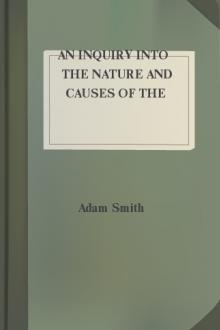The Wealth of Nations by Adam Smith (the best motivational books .TXT) 📕

- Author: Adam Smith
Book online «The Wealth of Nations by Adam Smith (the best motivational books .TXT) 📕». Author Adam Smith
The index s.v. Bank gives the name, “the Ayr bank.” Its head office was at Ayr, but it had branches at Edinburgh and Dumfries. A detailed history of it is to be found in The Precipitation and Fall of Messrs. Douglas, Heron and Company, Late Bankers in Air with the Causes of Their Distress and Ruin Investigated and Considered by a Committee of Inquiry Appointed by the Proprietors, Edinburgh, 1778. From this it appears that Smith’s account of the proceedings of the bank is extremely accurate, a fact which is doubtless due to his old pupil, the Duke of Buccleuch, having been one of the principal shareholders. Writing to Pulteney on 5th September, 1772, Smith says, “though I have had no concern myself in the public calamities, some of the friends in whom I interest myself the most have been deeply concerned in them; and my attention has been a good deal occupied about the most proper method of extricating them.” The extrication was effected chiefly by the sale of redeemable annuities. See Rae, Life of Adam Smith, 1895, pp. 253–255; David Macpherson, Annals of Commerce, vol. iii, pp. 525, 553; House of Commons’ Journals, vol. xxxiv, pp. 493–495, and the Act of Parliament, 14 Geo. III, c. 21. The East India Company opposed the bill on the ground that the bonds to be issued would compete with theirs, but their opposition was defeated by a vote of 176 to 36 in the House of Commons, Journals, vol. xxxiv, p. 601. ↩
Ed. 1 does not contain “those.” ↩
Macpherson, Annals of Commerce, vol. iii, p. 525, says the partners were the Dukes of Buccleuch and Queensberry, the Earl of Dumfries, Mr. Douglas and many other gentlemen. ↩
Lectures, p. 211. The bookseller’s preface to the 2nd ed. of Money and Trade (see this note) says the work consists of “some heads of a scheme which Mr. Law proposed to the Parliament of Scotland in the year 1705.” ↩
These two books are in Bonar, Catalogue of Adam Smith’s Library, pp. 35, 36. Du Tot’s is Réflections politiques sur les Finances et le Commerce, où l’on examine quelles ont été sur les revenus, les denrées, le change étranger et conséquemment sur notre commerce, les influences des augmentations et des diminutions des valeurs numéraires des monnoyes, La Haye, 1754. Du Verney’s is Examen du livre intitulé “Réflections politiques sur les Finances et le Commerce,” La Haye, 1740. ↩
In Lectures there is an account, apparently derived from Du Verney, which extends over eight pages, 211–218. ↩
Money and Trade Considered, with a Proposal for Supplying the Nation with Money, 1705. ↩
James Postlethwaite’s History of the Public Revenue, page 301. —Smith
History of the Public Revenue from 1688 to 1753, with an Appendix to 1758, by James Postlethwayt, F.R.S., 1759. —Cannan ↩
These three lines are not in ed. 1. ↩
From “it was incorporated,” here, to this point is an abstract of the “Historical State of the Bank of England,” in Postlethwayt’s History of the Public Revenue, pp. 301–310. The totals are taken from the bottom of Postlethwayt’s pages. ↩
In 1745, Magens, Universal Merchant, p. 31, suggests that there may have been suspicions that the money was being drawn out for the support of the rebellion. ↩
Eds. 1 and 2 read “him.” ↩
The Bank of England issued none under £20 till 1759, when £15 and £10 notes were introduced. —Anderson, Commerce, AD 1759 ↩
5 Geo. III, c. 49. ↩
The reference is probably to the passages in the “Discourse of Money,” and the “Discourse of the Balance of Trade,” where Hume censures paper money as the cause of a rise of prices. —Political Discourses, 1752, pp. 43–45, 89–91; cp. Lectures, p. 197 ↩
5 Geo. III, c. 49; referred to above, here. ↩
15 Geo. III, c. 51. ↩
“A knavish device of fraudulent debtors of the loan money to pay off their loans at a very depreciated value.” William Douglass, M.D., Summary, Historical and Political, of the First Planting, Progressive Improvements, and Present State of the British Settlements in North America, 1760, vol. ii, p. 107. The author uses strong language in many places about what he calls “this accursed affair of plantation paper currencies,” vol. ii, p. 13, note (s); cp. vol. i, pp. 310, 359; vol. ii, pp. 254–255, 334–335. ↩
4 Geo. III, c. 34. ↩
Below, this section. See also the “Advertisement” or preface to the 4th ed., above. ↩
Ed. 1 reads “This account of the Bank of Amsterdam, however, I have reason to believe, is altogether chimerical.” ↩
Ed. 1 reads “sink the value of gold and silver, or occasion equal quantities of those metals.” ↩
Some French authors of great learning and ingenuity have used those words in a different sense. In the last chapter of the fourth book I shall endeavour to show that their sense is an improper one. ↩
In the argument which follows in the text the fact is overlooked that this is only true when the manufacturers are employed to produce commodities





Comments (0)